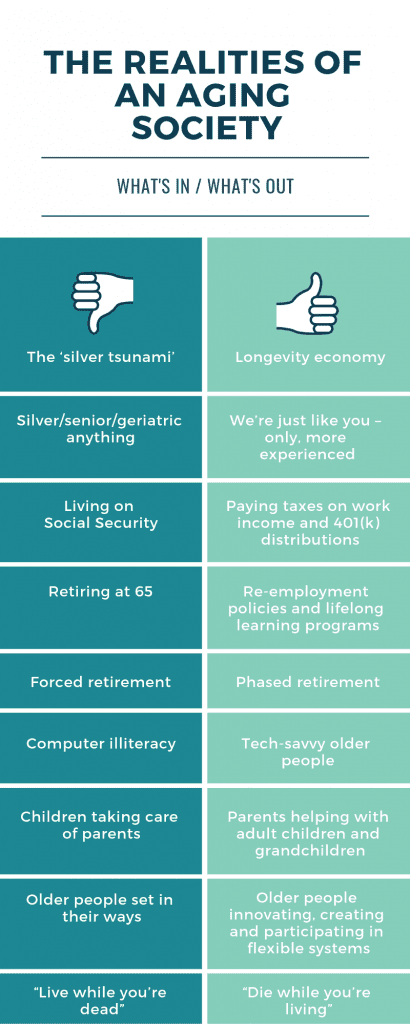Sevenstep Team | March 18, 2019
Several years ago, I led the marketing team for one of the world’s largest engineering firms. It was a dream job for any marketing professional who enjoys selling through story-telling. I met teams around the world who were working on everything from hydroelectric tunnels in Canada, to nickel mines in Brazil, to lithium plants in China.
What stood out for me in that job versus any I’d had before – or since – is just how many of the senior engineers I met were career boomerangs. Many were in their 70s – men (mostly, which is a whole other topic) who had cycled in and out of retirement several times over.
According to the Bureau of Labor Statistics, the median age of a U.S. worker is 42.2 years old. But the workforce is trending grayer. People aged 55 and older make up less than a quarter of all workers, but they filled 49% of the 2.9 million jobs created in 2018.
 Infographic Credit: Gerentological Society of America
Infographic Credit: Gerentological Society of America
This is a win for today’s employer. It makes for a deeper talent pool, and older workers obviously bring experience and maturity to their jobs. They also tend to be more engaged and more loyal. That’s good for productivity, and for minimizing turnover, but it’s also a powerful way to model the right behaviors for younger workers.
So how do organizations attract – and retain – this important cohort of candidates? It’s an issue facing many industries that are staring down a wave of upcoming retirements: airline pilots and flight attendants; doctors and nurses; agricultural professionals; accountants and auditors; construction and building inspectors; and, the aforementioned engineering profession.
Here are a few universal truths that any company can use to tap into this demographic – courtesy of a newly minted member of the American Association of Retired Persons (AARP):
- Compensation: The primary reason most people continue working past retirement age is financial. It’s vital to offer a total compensation package that includes a good healthcare plan, retirement options and competitive pay. In the United States, organizations that offer discounted packages to supplement shortfalls in Medicare coverage, for example, will be especially attractive.
- Accommodation: In jobs that require physical exertion, older workers will be challenged to keep up and safety is always paramount. Several years ago, BMW retooled one of its production facilities to accommodate older workers by installing softer floors, fitting more ergonomic seating, and even providing more supportive work boots. The result was increased productivity and dramatically reduced absences. The adjustments don’t all have to be physical. Consumer healthcare giant CVS implemented a plan several years ago that enables older workers to temporarily transfer to stores in warmer climates during winter months.
- Mentorship and Training: Older workers – especially in ‘professional’ careers – are keen to mentor younger colleagues. Setting up formal mentorship programs can be a key selling point for both groups. A lot of U.S. accounting and consulting firms mandate that partners retire in their early 60s, but PKF O’Connor is bucking that trend by hiring many of them to mentor its younger professionals. The reverse is also true. A study by the AARP found that more than 80% of workers aged 45-64 see the opportunity to learn as an attractive feature of a new job. It’s especially relevant in more labor-intensive roles, as automation displaces people on the shop floor, and they’re forced to look for job opportunities where they have little or no previous experience.
- Eliminate Bias: Whether it’s conscious or not, older candidates can often be adversely impacted by age bias in the recruitment process. They may be perceived as too expensive, over-qualified, or even less motivated than younger candidates. First, it’s vital to eliminate questions from the interview process that might – again, consciously or not – lead interviewers and hiring managers to draw these kinds of conclusions. Assessments that focus on tasks that are relevant to the job can help reduce judgements based on a candidate’s demographics. And it’s vital to train all employees, not just those in recruitment, to recognize and eliminate age discrimination. This is an area where technology is making a real difference. While artificial intelligence still requires some human intervention in the HR world, it is helping to reduce unconscious bias in the recruitment process by flagging potential bias in position descriptions, and reducing the opportunity for it to creep into resume parsing.
- Promote Yourself: How many organizations’ employer value proposition target younger workers primarily? Again, it may not be a conscious choice, but focusing almost entirely on career advancement and personal growth can be a red flag to older candidates that an organization just isn’t right for them. Smart companies are promoting how they cater to older employers by telling real-life stories about programs to help older employees maintain a healthy lifestyle, or prepare themselves financially for retirement.
- Tend to Your Alumni: When someone leaves your organization – especially a high performer or someone with specialist skills – that shouldn’t be the end of your relationship. When we talk to clients about their talent acquisition strategies, we suggest creating a re-hire check process to identify who they’d welcome back – especially for hard-to-fill skills and roles. Many companies in industries like consulting, accounting, engineering and software, court their alumni – both passively and proactively. I worked half my career at Deloitte, and I’m an active member of its alumni program. It enables me to keep up with company news, attend alumni get-togethers, and even take part in its employee purchasing program. These strategies can work for boomerang employees at any stage of their career, of course.
- Just Do It: There’s nothing more meaningful to an older worker – or any worker, really – than feeling like they’re an equal, valued part of the team. Most don’t see themselves as ‘old’ to begin with. They don’t want to feel as though people look at them like they’re less productive or less motivated because they’re not in it for the long haul. They just want to be treated, and valued, like everyone else.
As the average age of our population rises, we are in the midst of a real opportunity to create a society that values the experience and potential of older workers to create a more dynamic economy. And it’s absolutely essential that we do so: by 2040, there will be 2.7 working-age Americans for each retiree, down from 4.8 in 2010.
Employers – and especially, talent acquisition professionals – have a vital role to play in helping us meet this challenge.


